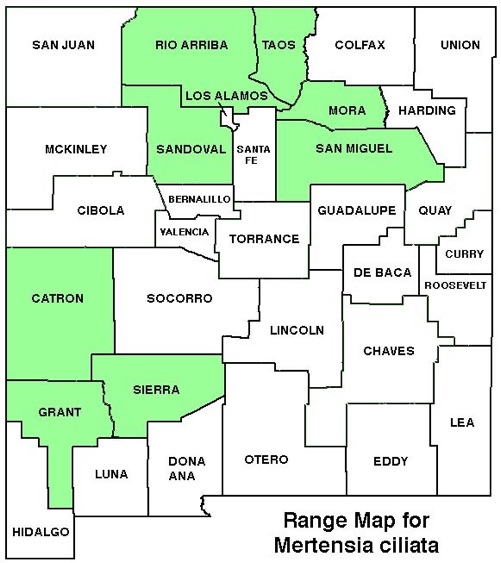WILDFLOWERS OF NEW MEXICO

Masses of 16–45-inch tall plants with blue-green leaves can cover mountain streambanks and moist meadows with clusters of hanging, bell-shaped blue flowers. Note the waxy, blue-green stem leaves with conspicuous lateral veins and the ciliate hairs along the leaf edges.
FLOWER: May–August. Clusters of hanging blue, fragrant flowers 3/8–3/4-inch long (10–17 mm); tube expands abruptly into bell shape, throat often has a ring of hairs; anthers inside throat, style extends beyond throat; calyx lobes lined with ciliate hairs, divided to base.
LEAVES: Basal; alternate on stem. Blades blue-green, elliptic to lance-shaped; surfaces hairless with conspicuous network of veins, mostly hairless, minute ciliate hairs along edges (use lens).
HABITAT: Moist soils; subalpine mountains and meadows, streamsides.
ELEVATION: 7,900–12,000 feet.
RANGE: AZ, CO, ID, MT, NM, NV, OR, UT, SD, WY.
SIMILAR SPECIES: The high altitude habitat and waxy, blue-green leaves with conspicuous lateral veins and the ciliate hairs along the edges help distinguish this species. Franciscan Bluebells, M. franciscana, in much the same range and habitat, also has broad leaves with a textured network of veins, but the top surface is covered with stiff hairs and is a lighter green.
NM COUNTIES: Northern and sw mountains in high-elevation, moist habitats: Catron, Grant, Luna, Mora, Rio Arriba, San Miguel, Sandoval, Taos.









TALL FRINGED (STREAMSIDE) BLUEBELLS
MERTENSIA CILIATA
Borage Family, Boraginaceae
Perennial herb









THE CONTENTS OF THIS WEBSITE ARE COPYRIGHTED AND CANNOT BE USED
WITHOUT PERMISSION OF GEORGE OXFORD MILLER

















Leaf surfaces are hairless and have a pronounced network of lateral veins.


















• Calyx lobes are divided to the base (upper arrow).
• Leaf surfaces hairless (but with little bumps) with ciliate hairs along margin (lower arrow).


Reaching four-feet tall, dense stands can cover stream sides and mountain meadows.

















EMAIL ME







